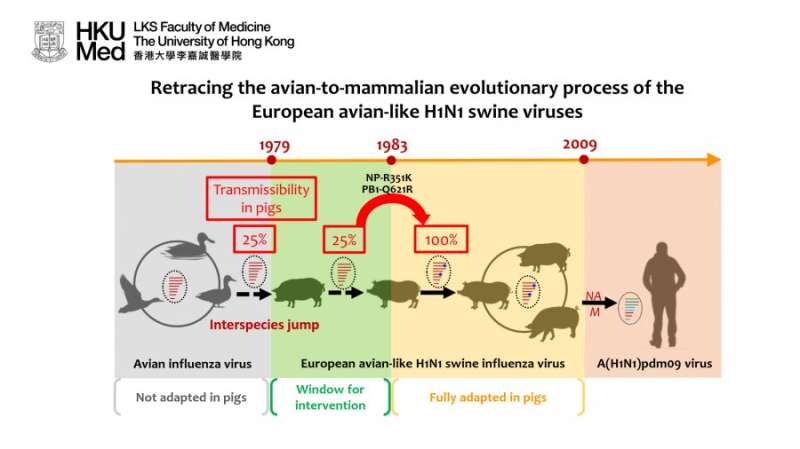Ancestral sequence reconstruction of avian influenza virus transmission in pigs

Researchers at the School of Public Health, LKS Faculty of Medicine of The University of Hong Kong (HKUMed), in collaboration with Duke-NUS Medical School (Duke-NUS) and St. Jude Children's Research Hospital (SJCRH), retraced the natural avian-to-mammalian evolutionary process of the European avian-like H1N1 (EA) swine influenza viruses that jumped species in the late 1970s.
Researchers found that recombinant viruses representing different adaptive stages of the EA swine influenza viruses were reconstructed and characterized to identify step-wise molecular changes in the viral polymerase and nucleoprotein that facilitated efficient pig-to-pig transmission. The results suggest strategic coordination of surveillance and risk assessment activities may help to identify viruses with pandemic potential before they become fully adapted in the mammalian species. The findings are now published in the latest issue of Nature Microbiology.
Pandemic influenza viruses that possess sustained human-to-human transmissibility may emerge after interspecies transmission of animal influenza viruses. Understanding the evolutionary steps taken by avian influenza viruses as they adapt to mammals will help us to better monitor zoonotic influenza viruses with pandemic potential. A limited number of avian-origin influenza viruses have successfully established in mammalian hosts. These viruses offer the best opportunities to identify the molecular determinants for successful establishment of avian influenza viruses in mammals.
Led by Dr. Yen Hui-ling, Associate Professor of the Division of Public Health Laboratory Sciences, School of Public Health, HKUMed; Dr. Richard Webby, Department of Infectious Diseases of SJCRH; and Professor Gavin James Smith, Emerging Infectious Diseases Programme of Duke-NUS, the research team aimed to dissect and study viral evolution that had already occurred in nature by applying ancestral sequence reconstruction, based on sequence information of existing low pathogenic avian influenza virus and EA swine influenza viruses, to gain viruses representing different adaptive stages of the EA swine influenza virus as it transitioned from avian to swine hosts since 1979.
The research team demonstrated that efficient transmission of the EA swine influenza virus in piglets was gained through stepwise adaptations, with changes in viral attachment to sialyl receptors and increased replication potential in mammalian cells. Mutations in the viral polymerase (PB1-Q621R) and nucleoprotein (NP-R351K) found to be fixed in circulating EA swine influenza viruses after 1983 significantly increased viral transmissibility in piglets.
The results suggest that ancestral sequence reconstruction is a suitable approach to investigate cross-species transmission and host adaptation of newly emerged pathogens. These results further suggest that there may be the opportunity to intervene at the early stage as avian influenza viruses adapt to mammalian hosts. Intervention strategies include viral surveillance at human-animal interface where spillover infections may occur, and risk assessment studies on newly emerged viruses before they become fully adapted to a new host. These strategies are most likely to be successful and represent the best use of limited preparedness resources.
More information: Wen Su et al, Ancestral sequence reconstruction pinpoints adaptations that enable avian influenza virus transmission in pigs, Nature Microbiology (2021). DOI: 10.1038/s41564-021-00976-y
Journal information: Nature Microbiology
Provided by The University of Hong Kong




















